TOYOTA SIENNA 2018 Owners Manual (in English)
Manufacturer: TOYOTA, Model Year: 2018, Model line: SIENNA, Model: TOYOTA SIENNA 2018Pages: 584, PDF Size: 14.47 MB
Page 141 of 584
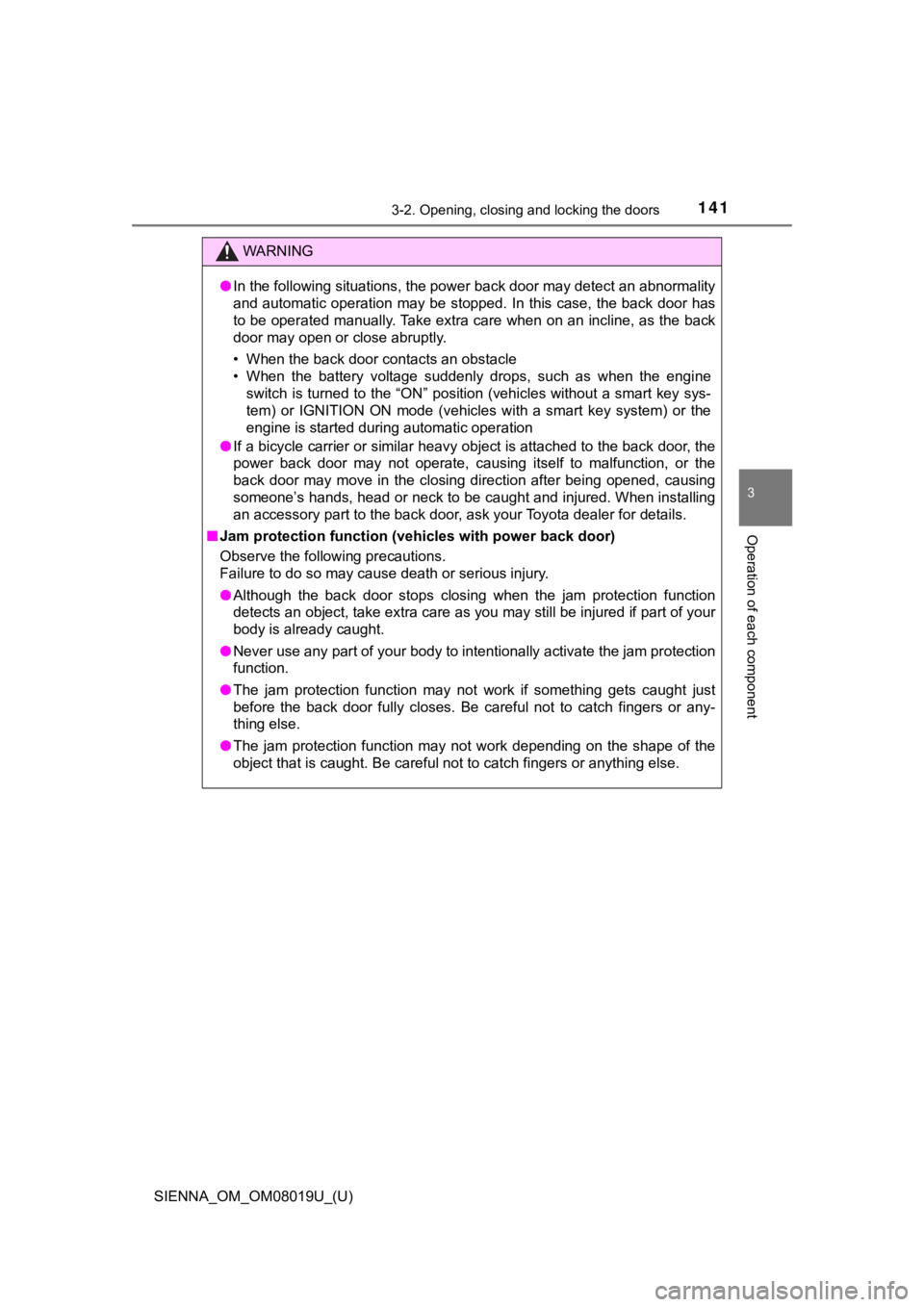
SIENNA_OM_OM08019U_(U)
1413-2. Opening, closing and locking the doors
3
Operation of each component
WARNING
●In the following situations, the power back door may detect an abnormality
and automatic operation may be stopped. In this case, the back door has
to be operated manually. Take extra care when on an incline, as the back
door may open or close abruptly.
• When the back door contacts an obstacle
• When the battery voltage suddenly drops, such as when the engi ne
switch is turned to the “ON” position (vehicles without a smart key sys-
tem) or IGNITION ON mode (vehicles with a smart key system) or the
engine is started during automatic operation
● If a bicycle carrier or similar heavy object is attached to the back door, the
power back door may not operate, causing itself to malfunction, or the
back door may move in the closing direction after being opened, causing
someone’s hands, head or neck to be caught and injured. When in stalling
an accessory part to the back door, ask your Toyota dealer for details.
■ Jam protection function (veh icles with power back door)
Observe the following precautions.
Failure to do so may cause death or serious injury.
● Although the back door stops closing when the jam protection fu nction
detects an object, take extra care as you may still be injured if part of your
body is already caught.
● Never use any part of your body to intentionally activate the j am protection
function.
● The jam protection function may not work if something gets caught just
before the back door fully closes. Be careful not to catch fing ers or any-
thing else.
● The jam protection function may not work depending on the shape of the
object that is caught. Be careful not to catch fingers or anything else.
Page 142 of 584
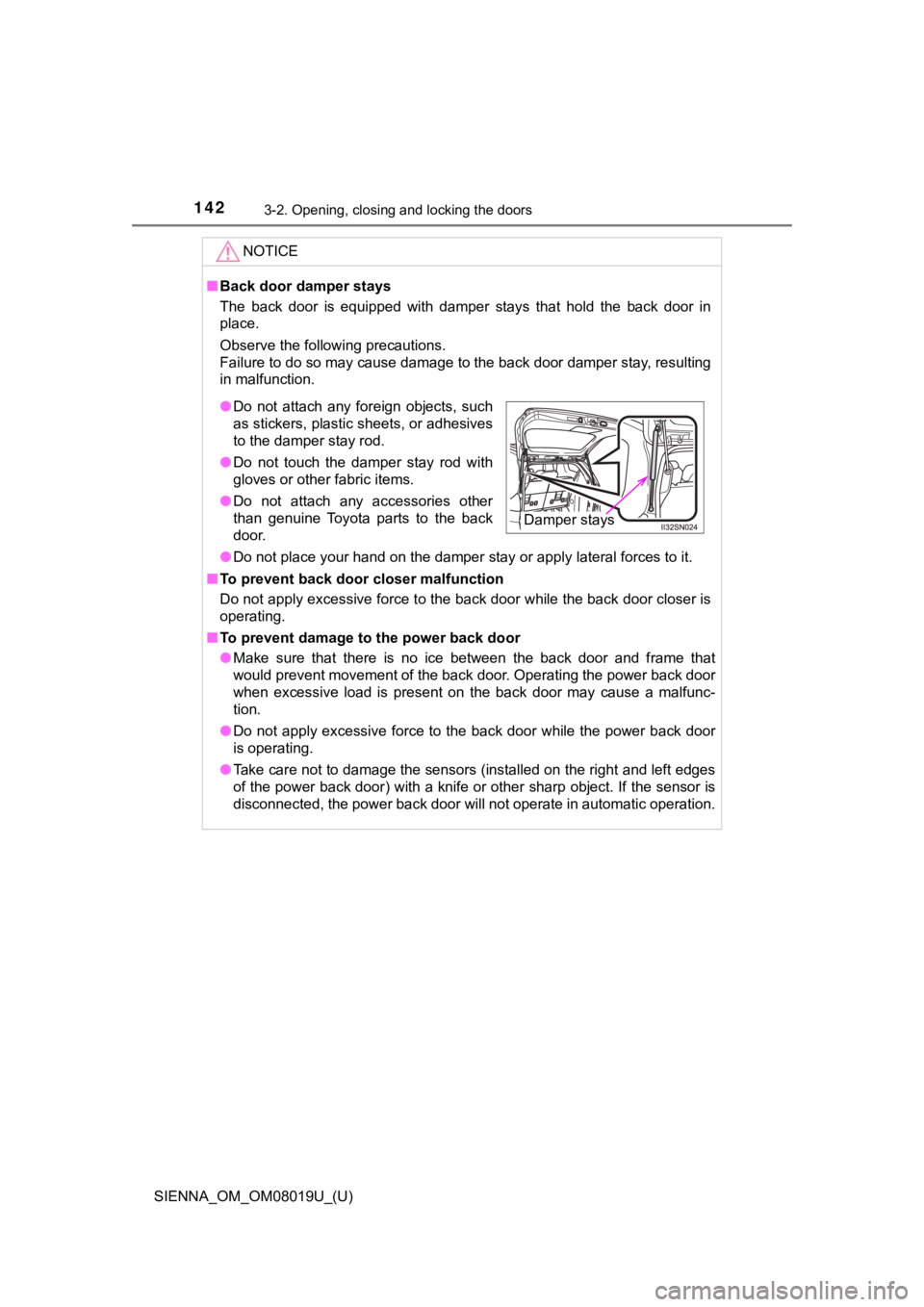
142
SIENNA_OM_OM08019U_(U)
3-2. Opening, closing and locking the doors
NOTICE
■Back door damper stays
The back door is equipped with damper stays that hold the back door in
place.
Observe the following precautions.
Failure to do so may cause damage to the back door damper stay, resulting
in malfunction.
● Do not place your hand on the damper stay or apply lateral forc es to it.
■ To prevent back door closer malfunction
Do not apply excessive force to the back door while the back door closer is
operating.
■ To prevent damage to the power back door
● Make sure that there is no ice between the back door and frame that
would prevent movement of the back door. Operating the power ba ck door
when excessive load is present on the back door may cause a mal func-
tion.
● Do not apply excessive force to the back door while the power b ack door
is operating.
● Take care not to damage the sensors (installed on the right and left edges
of the power back door) with a knife or other sharp object. If the sensor is
disconnected, the power back door will not operate in automatic operation.
●Do not attach any foreign objects, such
as stickers, plastic sheets, or adhesives
to the damper stay rod.
● Do not touch the damper stay rod with
gloves or other fabric items.
● Do not attach any accessories other
than genuine Toyota parts to the back
door.
Damper stays
Page 143 of 584
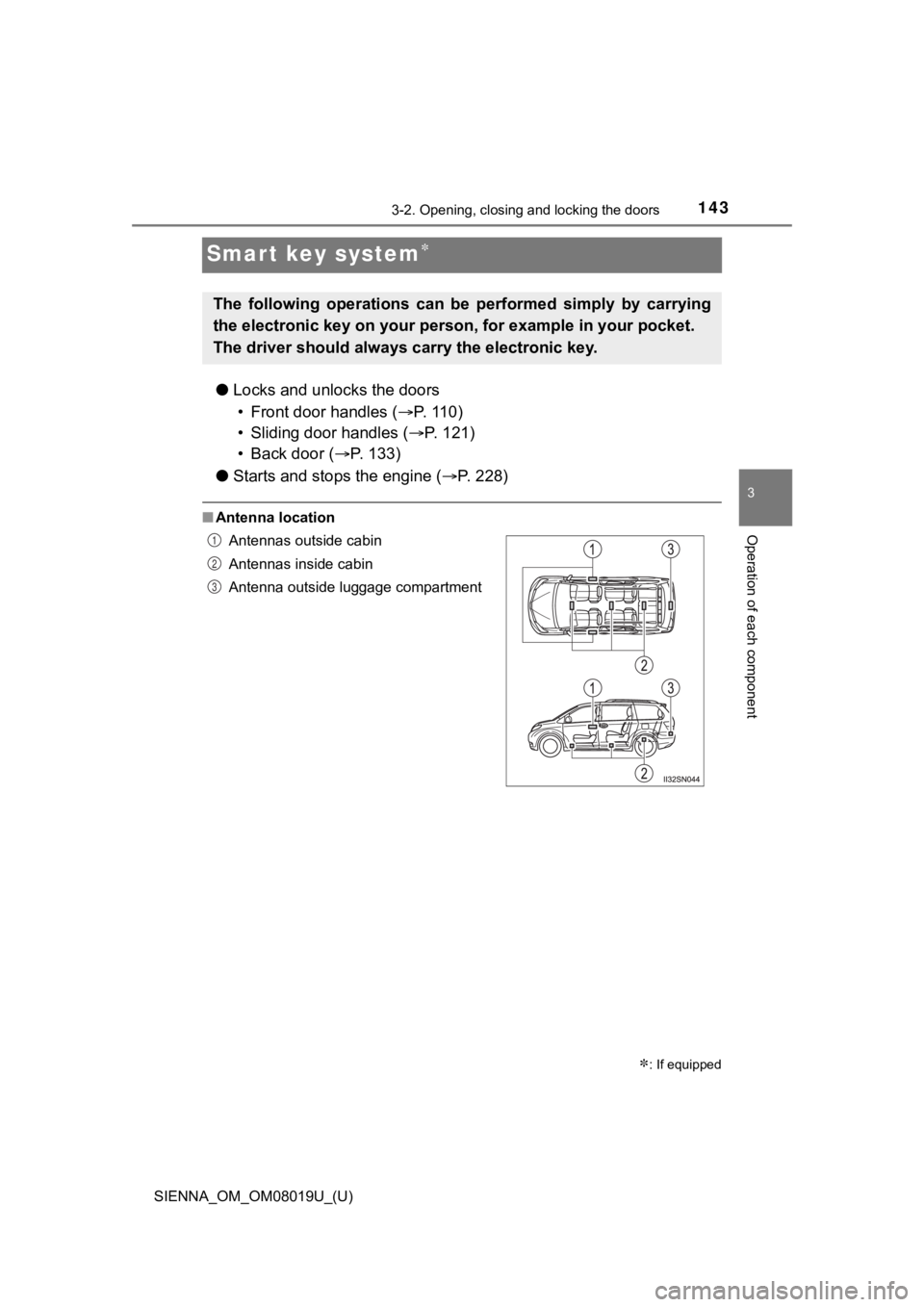
143
SIENNA_OM_OM08019U_(U)
3-2. Opening, closing and locking the doors
3
Operation of each component
Smart key system
●Locks and unloc ks the doors
• Front door handles ( P. 110)
• Sliding door handles ( P. 121)
• Back door ( P. 133)
● Starts and sto ps the engine ( P. 228)
■Antenna location
: If equipped
The following operations can be performed simply by carrying
the electronic key on your person, for example in your pocket.
The driver should always ca rry the electronic key.
Antennas outside cabin
Antennas inside cabin
Antenna outside luggage compartment1
2
3
Page 144 of 584
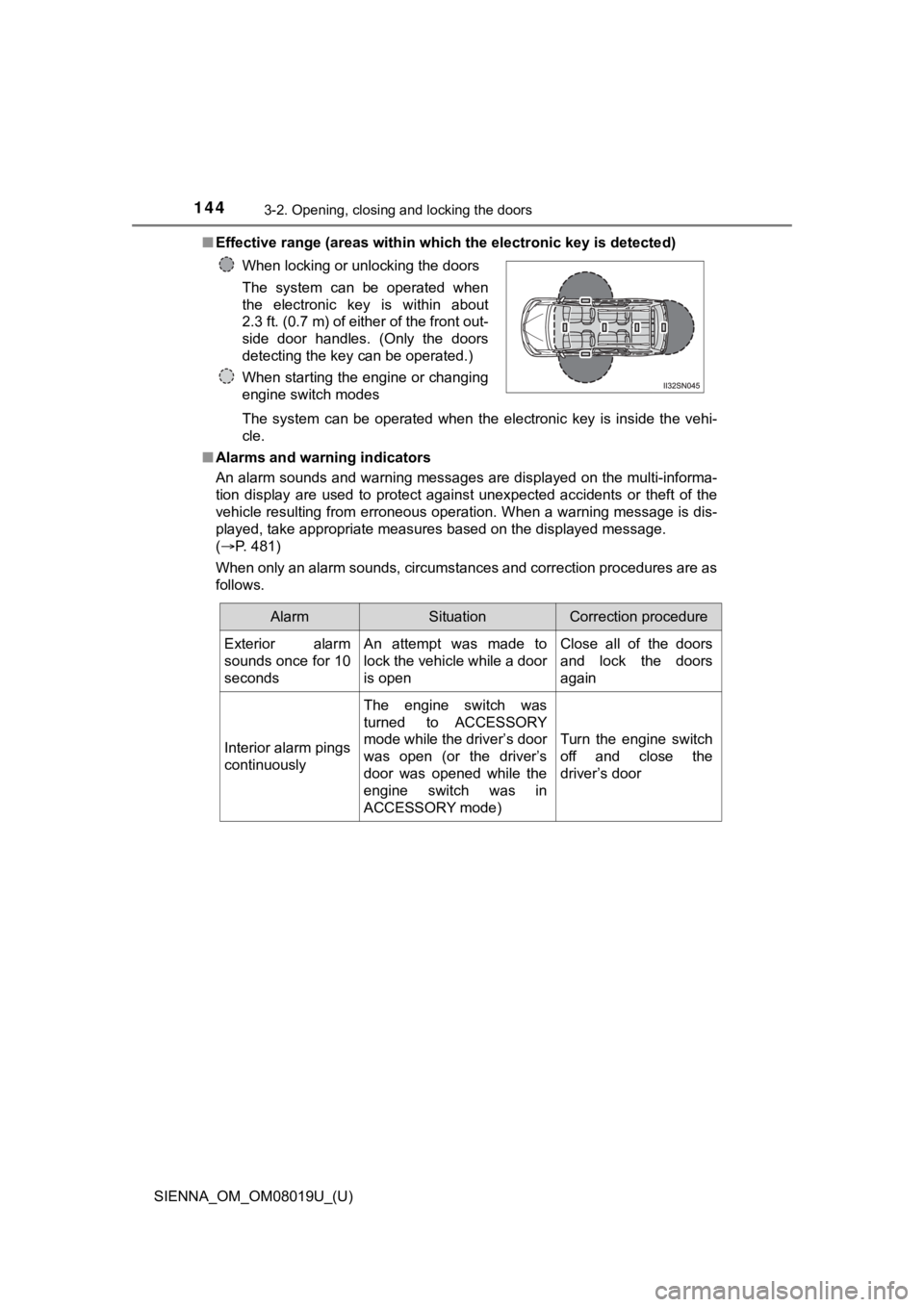
144
SIENNA_OM_OM08019U_(U)
3-2. Opening, closing and locking the doors
■Effective range (areas within wh ich the electronic key is detected)
The system can be operated when the electronic key is inside th e vehi-
cle.
■ Alarms and warning indicators
An alarm sounds and warning messages are displayed on the multi -informa-
tion display are used to protect against unexpected accidents o r theft of the
vehicle resulting from erroneous operation. When a warning mess age is dis-
played, take appropriate measures based on the displayed messag e.
( P. 481)
When only an alarm sounds, circumstances and correction procedu res are as
follows. When locking or unlocking the doors
The system can be operated when
the electronic key is within about
2.3 ft. (0.7 m) of either of the front out-
side door handles. (Only the doors
detecting the key can be operated.)
When starting the engine or changing
engine switch modes
AlarmSituationCorrection procedure
Exterior alarm
sounds once for 10
secondsAn attempt was made to
lock the vehicle while a door
is openClose all of the doors
and lock the doors
again
Interior alarm pings
continuously
The engine switch was
turned to ACCESSORY
mode while the driver’s door
was open (or the driver’s
door was opened while the
engine switch was in
ACCESSORY mode)
Turn the engine switch
off and close the
driver’s door
Page 145 of 584
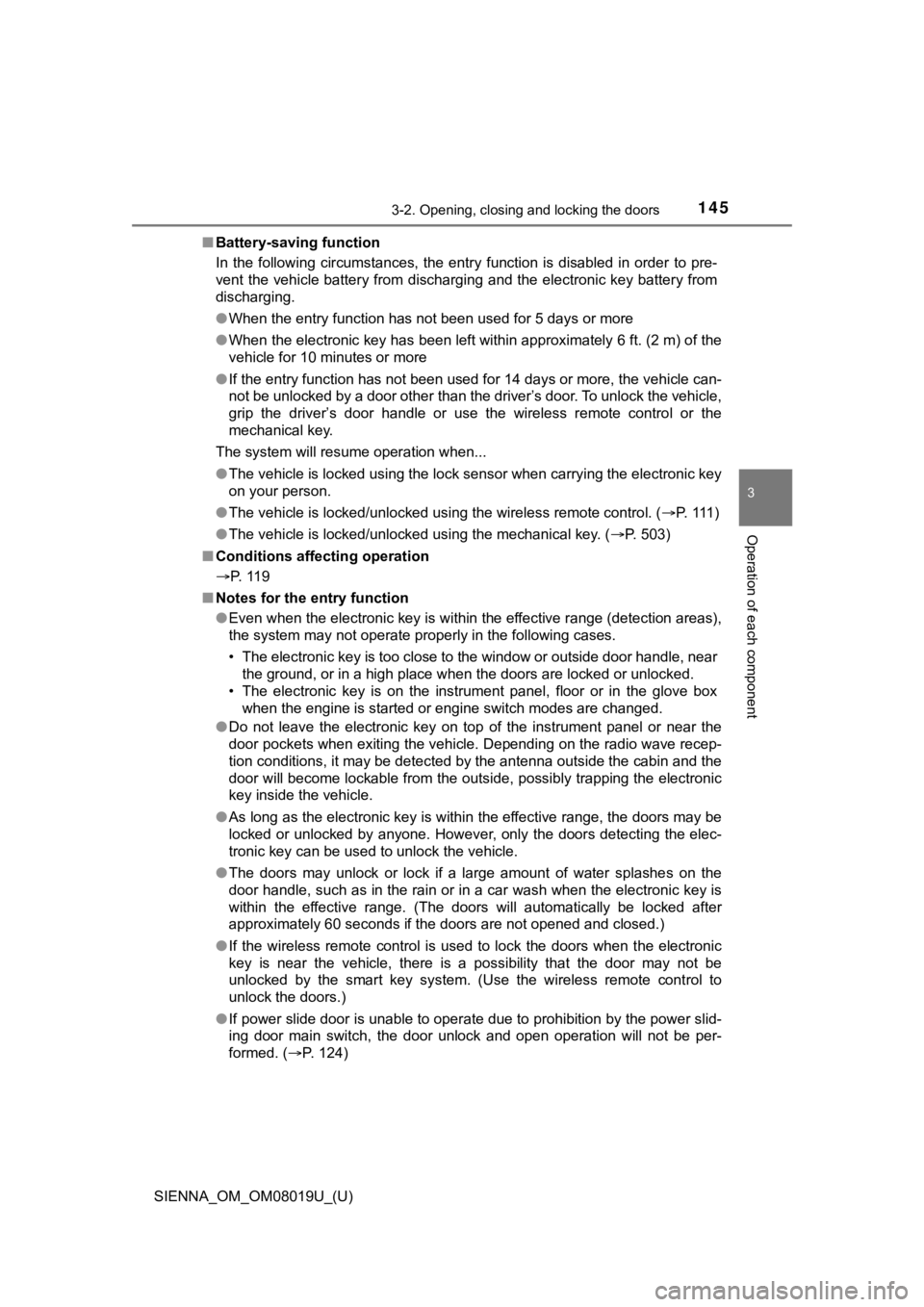
SIENNA_OM_OM08019U_(U)
1453-2. Opening, closing and locking the doors
3
Operation of each component
■Battery-saving function
In the following circumstances, the entry function is disabled in order to pre-
vent the vehicle battery from discharging and the electronic ke y battery from
discharging.
● When the entry function has not been used for 5 days or more
● When the electronic key has been left within approximately 6 ft. (2 m) of the
vehicle for 10 minutes or more
● If the entry function has not been used for 14 days or more, th e vehicle can-
not be unlocked by a door other than the driver’s door. To unlock the vehicle,
grip the driver’s door handle or use the wireless remote contro l or the
mechanical key.
The system will resume operation when...
● The vehicle is locked using the lock sensor when carrying the electronic key
on your person.
● The vehicle is locked/unlocked using the wireless remote contro l. (P. 1 1 1 )
● The vehicle is locked/unlocked using the mechanical key. ( P. 503)
■ Conditions affecting operation
P. 119
■ Notes for the entry function
●Even when the electronic key is within the effective range (det ection areas),
the system may not operate properly in the following cases.
• The electronic key is too close to the window or outside door handle, near
the ground, or in a high place when the doors are locked or unl ocked.
• The electronic key is on the instrument panel, floor or in the glove box
when the engine is started or engine switch modes are changed.
● Do not leave the electronic key on top of the instrument panel or near the
door pockets when exiting the vehicle. Depending on the radio w ave recep-
tion conditions, it may be detected by the antenna outside the cabin and the
door will become lockable from the outside, possibly trapping the electronic
key inside the vehicle.
● As long as the electronic key is within the effective range, th e doors may be
locked or unlocked by anyone. However, only the doors detecting the elec-
tronic key can be used to unlock the vehicle.
● The doors may unlock or lock if a large amount of water splashe s on the
door handle, such as in the rain or in a car wash when the elec tronic key is
within the effective range. (The doors will automatically be lo cked after
approximately 60 seconds if the doors are not opened and closed.)
● If the wireless remote control is used to lock the doors when t he electronic
key is near the vehicle, there is a possibility that the door m ay not be
unlocked by the smart key system. (Use the wireless remote cont rol to
unlock the doors.)
● If power slide door is unable to operate due to prohibition by the power slid-
ing door main switch, the door unlock and open operation will n ot be per-
formed. ( P. 124)
Page 146 of 584

146
SIENNA_OM_OM08019U_(U)
3-2. Opening, closing and locking the doors
■Note for locking the doors
●Touching the door lock sensor while wearing gloves may delay or prevent
lock operation. Remove the gloves and touch the lock sensor aga in.
● When the lock operation is performed using the lock sensor, rec ognition sig-
nals will be shown up to two consecutive times. After this, no recognition
signals will be given.
● If the door handle becomes wet while the electronic key is with in the effec-
tive range, the door may lock and unlock repeatedly. Place the key in a posi-
tion 6 ft. (2 m) or more separate from the vehicle while the ve hicle is being
washed. (Take care to ensure that the key is not stolen.)
● If the electronic key is inside the vehicle and a door handle b ecomes wet
during a car wash, a message may be shown on the multi-informat ion dis-
play and a buzzer will sound outside the vehicle. To turn off t he alarm, lock
all the doors.
● The lock sensor may not work properly if it comes into contact with ice,
snow, mud, etc. Clean the lock sensor and attempt to operate it again, or
use the lock sensor on the lower part of the door handle.
● Fingernails may scrape against the door during operation of the door han-
dle. Be careful not to injure fingernails or damage the surface of the door.
■ Notes for the un locking function
● Gripping the front door handle when wearing a glove may not unl ock or lock
the door.
● A sudden approach to the effective range or door handle operati on may pre-
vent the doors from being unlocked. In this case, return the do or handle to
the original position and check that the doors have unlocked be fore pulling
the door handle.
● If there is another electronic key in the detection area, it ma y take slightly
longer to unlock the doors after one of the front door handles is gripped or
one of sliding door handles is pulled.
■ When the vehicle is not driven for extended periods
●To prevent theft of the vehicle, do not leave the electronic ke y within 6 ft.
(2 m) of the vehicle.
● The smart key system can be deactivated in advance. ( P. 544)
Page 147 of 584
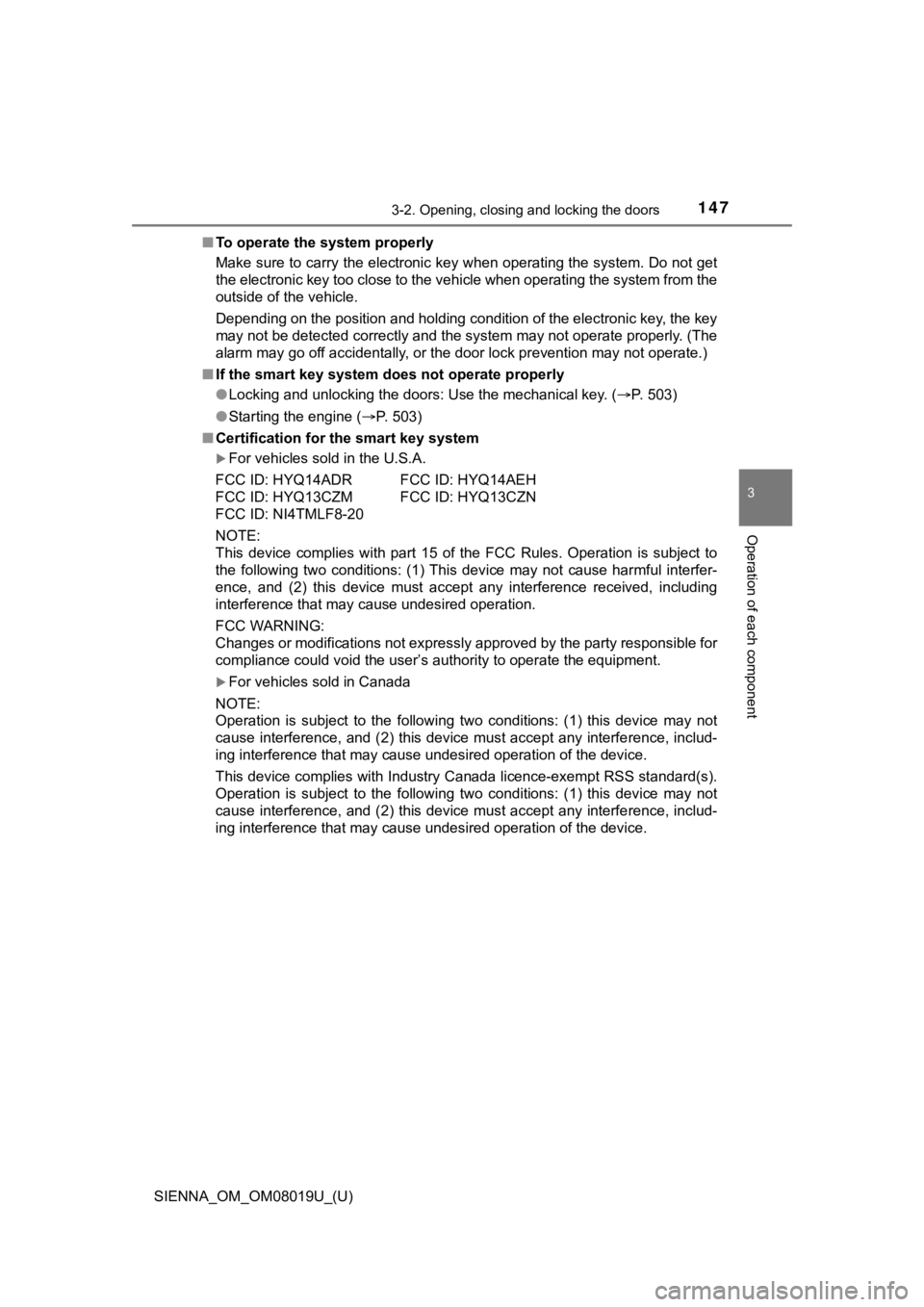
SIENNA_OM_OM08019U_(U)
1473-2. Opening, closing and locking the doors
3
Operation of each component
■To operate the system properly
Make sure to carry the electronic key when operating the system. Do not get
the electronic key too close to the vehicle when operating the system from the
outside of the vehicle.
Depending on the position and holding condition of the electron ic key, the key
may not be detected correctly and the system may not operate pr operly. (The
alarm may go off accidentally, or the door lock prevention may not operate.)
■ If the smart key system does not operate properly
●Locking and unlocking the doors: Use the mechanical key. ( P. 503)
● Starting the engine ( P. 503)
■ Certification for the smart key system
For vehicles sold in the U.S.A.
FCC ID: HYQ14ADR FCC ID: HYQ14AEH
FCC ID: HYQ13CZM FCC ID: HYQ13CZN
FCC ID: NI4TMLF8-20
NOTE:
This device complies with part 15 of the FCC Rules. Operation is subject to
the following two conditions: (1) This device may not cause har mful interfer-
ence, and (2) this device must accept any interference received, including
interference that may cause undesired operation.
FCC WARNING:
Changes or modifications not expressly approved by the party re sponsible for
compliance could void the user’s authority to operate the equip ment.
For vehicles sold in Canada
NOTE:
Operation is subject to the following two conditions: (1) this device may not
cause interference, and (2) this device must accept any interfe rence, includ-
ing interference that may cause undesired operation of the devi ce.
This device complies with Industry Canada licence-exempt RSS standard(s).
Operation is subject to the following two conditions: (1) this device may not
cause interference, and (2) this device must accept any interfe rence, includ-
ing interference that may cause undesired operation of the devi ce.
Page 148 of 584

148
SIENNA_OM_OM08019U_(U)
3-2. Opening, closing and locking the doors
■Customization
Settings (e.g. smart key system) can be changed.
(Customizable features: P. 543, 544)
■ If the smart key system has been d eactivated in a customized setting
● Locking and unlocking the doors:
Use the wireless remote control or mechanical key. ( P. 111, 503)
● Starting the engine and changing engine switch modes: P. 503
● Stopping the engine: P. 229
WARNING
■Caution regarding interfer ence with electronic devices
● People with implantable cardiac pacemakers, cardiac resynchroni zation
therapy-pacemakers or implantable cardioverter defibrillators s hould keep
away from the smart key system antennas. ( P. 143)
The radio waves may affect the operation of such devices. If ne cessary,
the entry function can be disabled. Ask your Toyota dealer for details, such
as the frequency of radio waves and timing of the emitted radio waves.
Then, consult your doctor to see if you should disable the entr y function.
● Users of any electrical medical device other than implantable c ardiac
pacemakers, cardiac resynchronization therapy-pacemakers or implant-
able cardioverter defibrillators should consult the manufacture r of the
device for information about its operation under the influence of radio
waves. Radio waves could have unexpected effects on the operati on of
such medical devices.
Ask your Toyota dealer for details for disabling the entry func tion.
Page 149 of 584
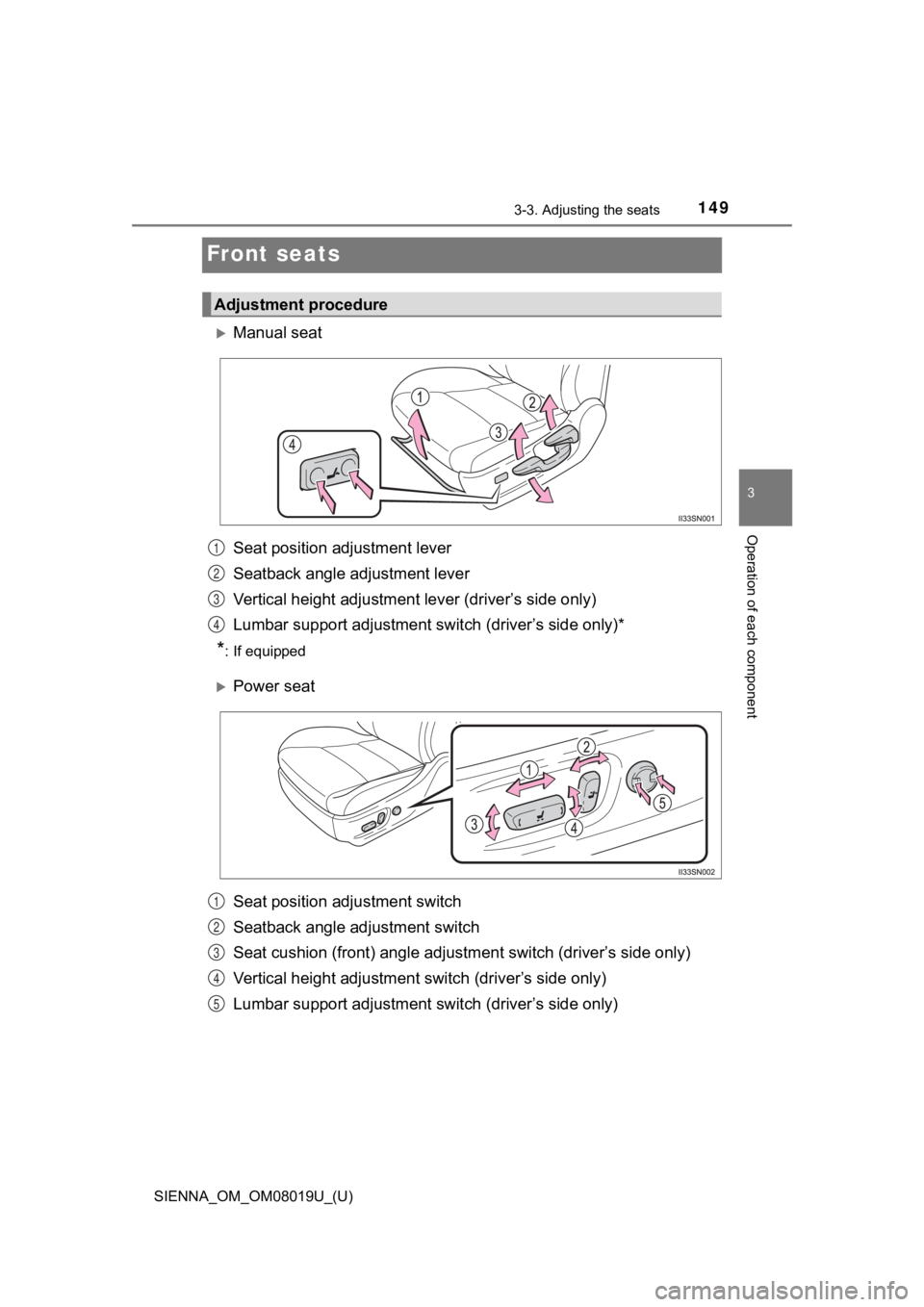
149
SIENNA_OM_OM08019U_(U)
3-3. Adjusting the seats
3
Operation of each component
Front seats
Manual seat
Seat position adjustment lever
Seatback angle adjustment lever
Vertical height adjustment lever (driver’s side only)
Lumbar support adjustment swi tch (driver’s side only)*
*: If equipped
Power seat
Seat position adjustment switch
Seatback angle adj ustment switch
Seat cushion (front) angle adjus tment switch (driver’s side only)
Vertical height adjustment sw itch (driver’s side only)
Lumbar support adjustment s witch (driver’s side only)
Adjustment procedure
1
2
3
4
1
2
3
4
5
Page 150 of 584
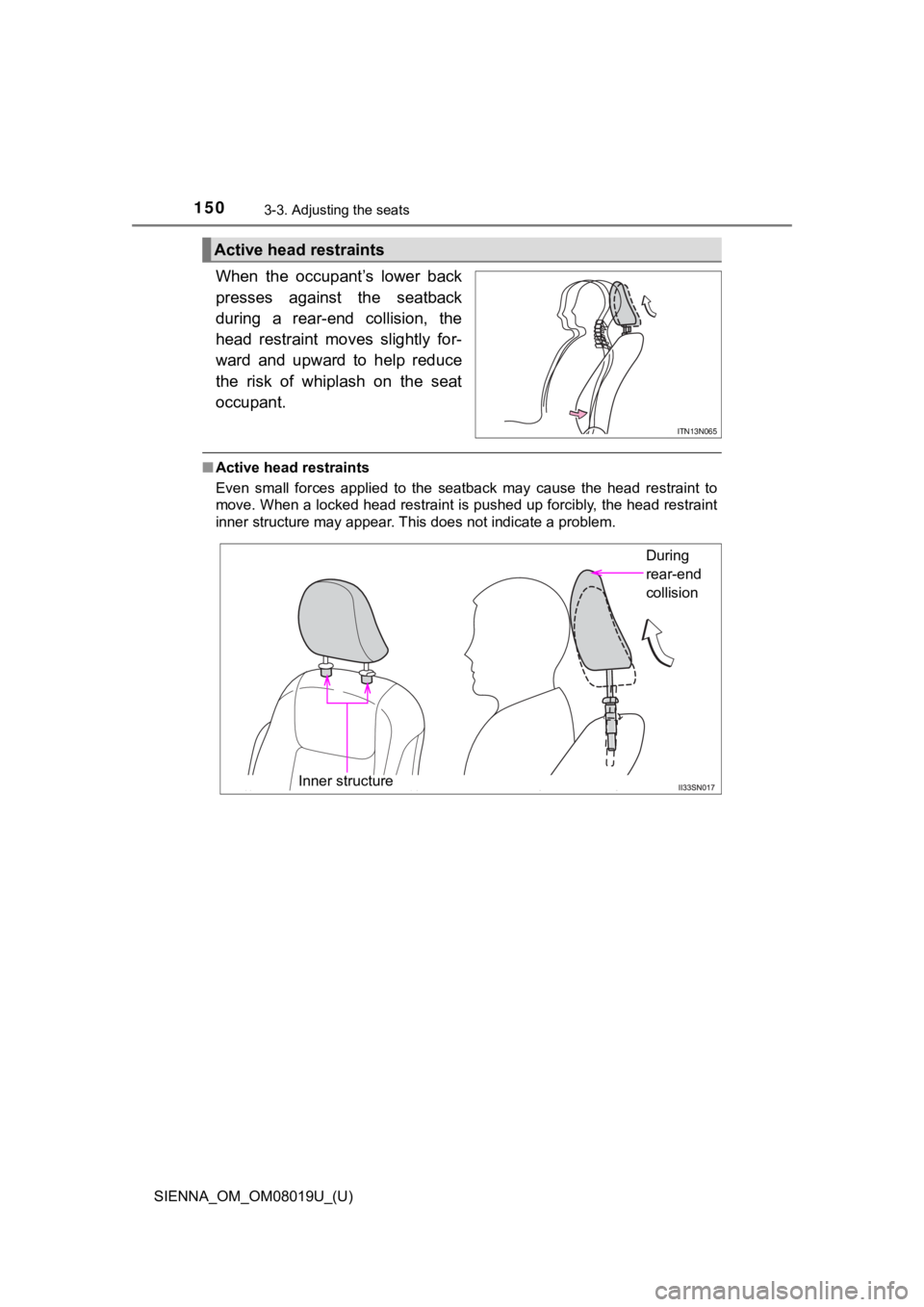
150
SIENNA_OM_OM08019U_(U)
3-3. Adjusting the seats
When the occupant’s lower back
presses against the seatback
during a rear-end collision, the
head restraint moves slightly for-
ward and upward to help reduce
the risk of whiplash on the seat
occupant.
■Active head restraints
Even small forces applied to the seatback may cause the head re straint to
move. When a locked head restraint is pushed up forcibly, the h ead restraint
inner structure may appear. This does not indicate a problem.
Active head restraints
ITN13N065
During
rear-end
collision
Inner structure